#Kimono Refashioned
Text

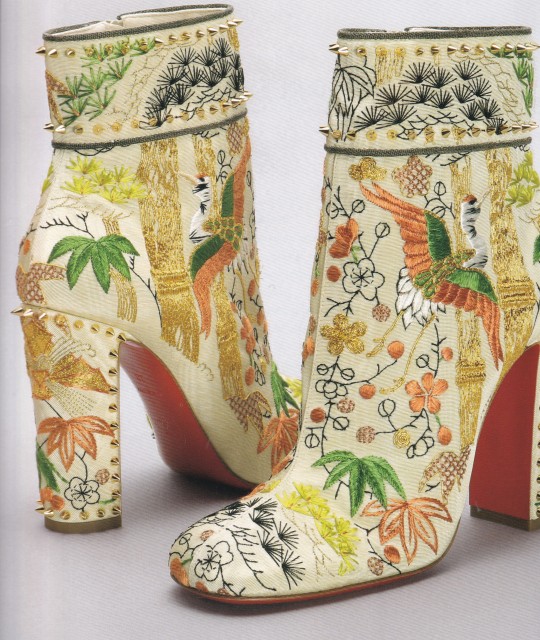



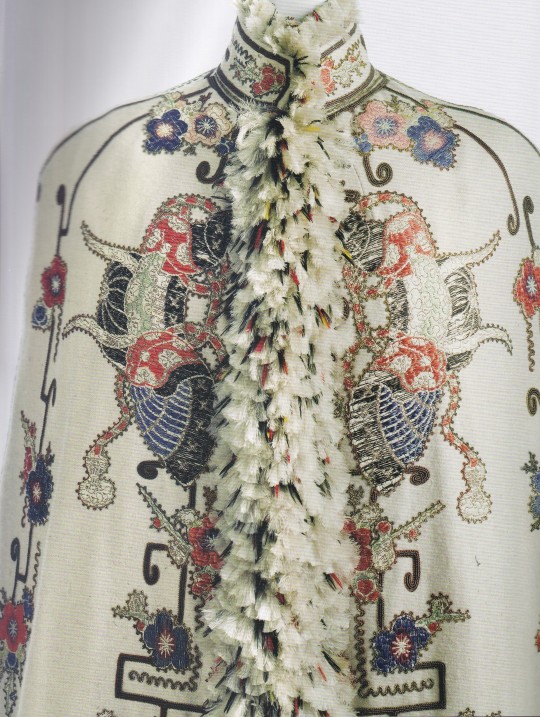





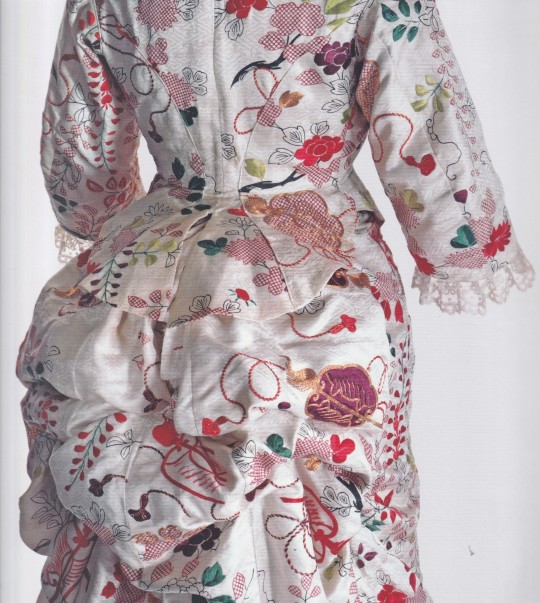
Kimono Refashioned
Japan's Impact on International Fashion
Edited by Yuki Morishima and Rie Nii, Essays by Akiko Fukai, Cynthia Amnéus, Katherine Anne Paul, Karin G. Oen, Yuki Morishima, and Rie Nii
Asian Art Museum, San Francisco 2018, 134 pages, 24x28cm, ISBN 978-0-939 117-85-7
euro 30,00
email if you want to buy [email protected]
Spanning East to West, kimonos and kimono-influenced designs are everywhere, from high-end couturiers such as Yohji Yamamoto and Gucci to Main Street fashion chains such as Uniqlo and H&M. In Kimono Refashioned, contributors explore the impact of the kimono on the fashion world, charting how these striking and elegant unisex garments came to transcend their traditional Japanese design origins. Featuring highlights from the renowned Kyoto Costume Institute, this lavish volume documents Japanese and Western designs, men's and women's apparel, and both exacting and impressionistic references to the kimono. Contributors from the Asian Art Museum of San Francisco, the Newark Museum, and the Cincinnati Art Museum join curators from the Kyoto Costume Institute to reflect upon the wide-range of motifs used to decorate kimonos, the form and silhouette of the Japanese traditional dress, and how its basic two-dimensional structure and linear cut have been refashioned into a wide array of garments. As captivating as the kimono itself, this book will be a must-have for fashionistas and Asian art aficionados alike.
02/02/24
#Kimono Refashioned#Kyoto Costume Institute#fashion exhibition catalogue#Cincinnati Newark SanFrancisco 2018 2019#Yohji Yamamoto#Rei Kawakubo#fashion books#fashionbooksmilano
15 notes
·
View notes
Text
Project: scarf to cardigan
Introduction:
Someone gifted me a chiffon scarf a while ago. They'd seen my previous scarf projects, and decided their own scarves would be better off in my fabric stash than unworn in their closet.
I already have plenty of scarves, so I decided to turn it into a cardigan.
The project:
I kept things really simple for this project. I reused my 1 hour dress pattern, or more specifically the one I drafted based on Mary Brooks Picken's drafting guide.
Instead of turning it into a dress like the original pattern, I cut the fabric open at the centre, and made the sides flare out.
I folded my fabric in half, then drew my pattern onto it and cut it out.
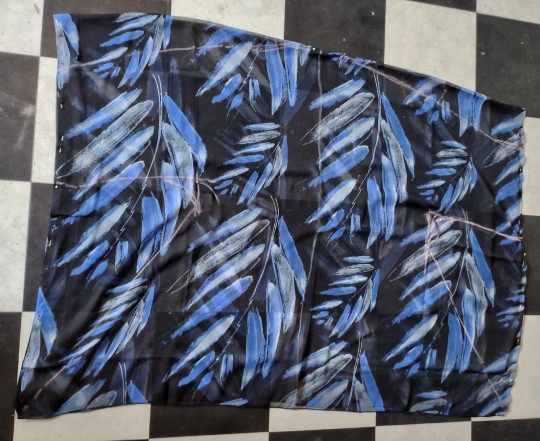
[ID: a black see-through scarf with blue leaves printed on it with with white details. The scarf has been folded in half and laid out flat on the floor. The sides are pinned together. A cardigan pattern has been drawn onto it with pink chalk.]
I used French seams to finish off the seams because the fabric was very prone to fraying. I then finished off my raw edges with a rolled hem (except for the sleeves, as the sides of the scarf were already finished).
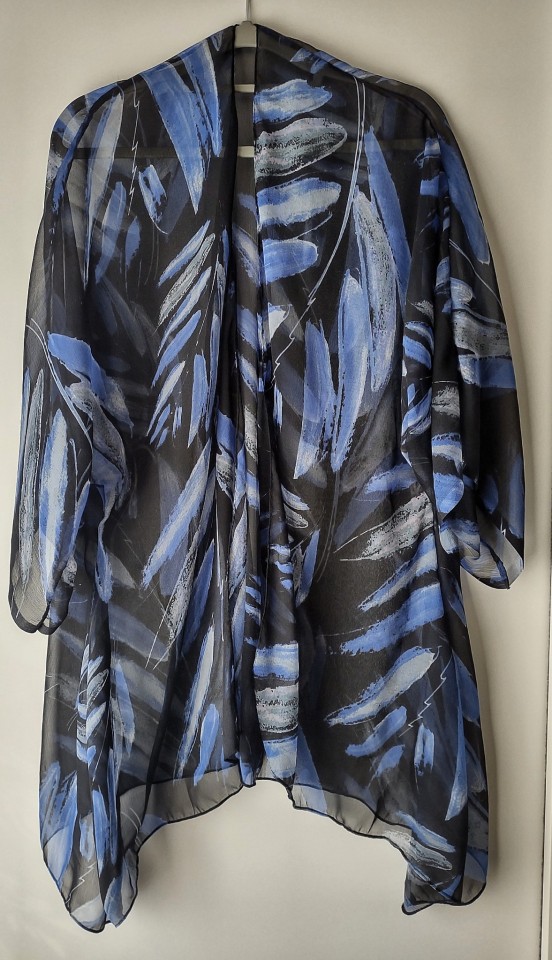
[ID: a black see-through cardigan with blue leaves printed on it with with white details handing from a hanger in front of a white background.]
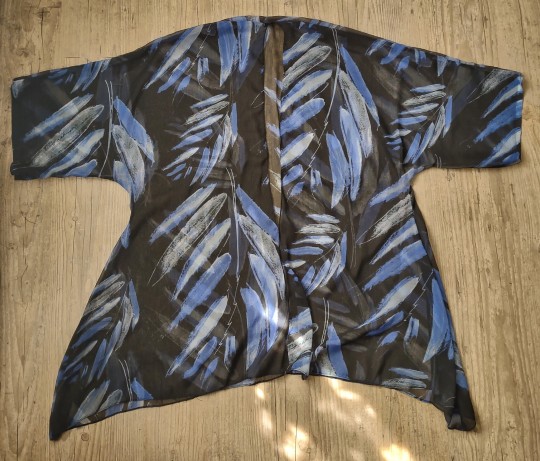
[ID: a black see-through cardigan with blue leaves printed on it with with white details lying flat on a wooden floor. The cardigan has kimono sleeves and flared sides.]
Conclusion:
This scarf refashion was nice and easy. The result was an airy cardigan that's perfect for warm weather nights when the temperatures are starting to come down a little.
I made the cardigan larger than needed for my specific body shape. This gives me wiggle room in case I gain weight in the future. It also gives this garment a better chance of finding a new home if I ever stop wearing it, because this style of cardigan looks flattering as both an oversized piece and a fitted piece which means it can be worn by a variety of sizes.
#wasteless crafts#project#cardigan#scarf#refashion#cardigan to scarf#diy#one hour dress#kimono sleeves#scarf refashion#fashion#slow fashion#fast fashion#sustainable fashion#sustainability#reduce reuse recycle#zero waste#zero waste crafts#sewing#crafts#fibre crafts#french seam#rolled hem#chiffon
282 notes
·
View notes
Note
I have just thought of this- now that the tenshu gang is in NY what would be their dressing styles? Idk I felt like now that there's malls and stuff maybe they dress diff (and also because they were just from Japan so they kinda gotta dress like how other people I'm guessing, or because they see new clothing Maybe they wanna wear that then what they wore in japan) and maybe how they express themselves .-.
I think they will get a style update. They still wear their old styles as they are the clothes they grew up in and the style is comfortable. But I do believe they get a wardrobe update.
Kitsune
Kitsune’s look is the closest to her Usagi Chronicles counterpart. She has the long red hair ponytail. She wears a long sleeve teal shirt and teal leggings. She has a lighted green kimono on top. It used to be her dance outfit but has been refashioned for everyday wear. This is why it has the golden leaves embroidered on it. I picture it to be a little more flowy then in the show.
When she comes to New York I think she will embrace the style change the most. I have two outfits right now for her. Teal leggings with a baggy light green or teal sweater. A pair of jean overalls shorts on top of it. A more modern and comfy look of what she has now.
The second would be a flowy light green dress. Pair with leggings underneath for movement and maybe a jacket. I’m still thinking about this one.
Gen
Gen doesn’t really care for fashion. His current outfit is more inline with the comics then the show. I think he would be a sweatpants, tank top, and over shirt kind of dude. The over shirt would be his purple haori.
He’s very laid back. If y’all got some ideas for him let me know.
Usagi
Usagi is the one that would hold on to tradition the most I think. He likes his traditional clothing. I think if he does update his look it would still have a samurai feel to it. Pants with pockets for sure. Much like Gen his haori would survive the update. (Leo loves when Usagi gives him his haori to wear and Usagi defiantly barrows Leo’s hoodies)
But I don’t know. I’ll open it up for you guys to play with.
They probably have some casually clothes to go out it. And formal wear when needed. (Magic town house like events)
31 notes
·
View notes
Note
hi buriko! I had a question about haori sizing. were haori of the taisho period standardized in size across gender/age group, or were they custom-made, or were they all one size? asking because I'm curious how giyuu was able to continue to wear the haori of his sister and sabito into adulthood. would tsutako and sabito's haori have been different sizes? did giyuu have to refashion each child-size haori into adult-size halves? would he have been at risk of outgrowing them? thank you :)
I'm afraid I don't have quick answers on haori sizes, and "haori" have come from so many other previous historical garments that it's hard to say what's standard! Even today, there are different kinds of kimono overcoats for women, and for men, haori nowadays feel like they are more formal than fashionable.
As a very quick rundown, overcoats like haori (and their predecessors) were only worn by men until the later Meiji period, and when women started wearing them (especially in the Taisho Period), it was especially fashionable to wear long haori. Therefore, lengthwise, I don't think this would had presented any issues. There was indeed a difference between men's and women's haori (and women enjoyed much, much more flamboyant patterns and colors as the period went on), and while I don't know how often they'd have been custom-made with rolls of fabric for sale as opposed to bought ready (you find both patterns nowadays), especially in rural versus fashionable urban places, many garments could be adjusted enough that they could be passed down through generations and still worn by people of somewhat different sizes.
However, the arm width might not had left Giyuu with much room to grow into, especially if meant for a woman's smaller frame (and although the manga doesn't show this, iirc, the Ufotable snapshot of Tsutako had her wearing it like a kimono with hakama instead of as a haori, so it would have been a different cut and fit in the first place). To cover such a generous amount of Giyuu's arm while still retaining the integrity of the original garment fitting together panels of fabric of finite width, I think he might have realistically had to at least replace the sleeves. Under the physical demands of demon slaying, it's probably suffered a lot of damage anyway.
While it's more meaningful to operate under the assumption that it's been the same fabric the whole time which his sister wore, the other reason I find it likely that Giyuu would have replaced pieces of his haori is because we don't know how, or even if he was able to attain Sabito's original. In his flashback in volume 15, we see Murata and one other boy telling him what happened when Giyuu wakes up covered in bandages, but they do not have Sabito's garments. If someone did manage to attain them and deliver them to Giyuu later, there's no telling how damaged they would have been. Perhaps he only used one half of it because the other half was salvageable (in comparison, as Tsutako was killed at night, she might have been wearing bed clothes instead).
I'm also comfortable with Giyuu retaining their memory but always being fastidious in choosing fabrics that are the same as Tsutako and Sabito's tastes, however hard it might be to always replicate perfectly, as he might not had wanted to damage their haori in the first place by cutting them in half. By now the Kakushi probably have his back on this and keep extras of that tortoiseshell pattern in storage.
But on that note, the Kakushi are probably really good at making size adjustments to haori of sentimental value to many of the Corp members. If Nezuko was able to repair, resize, and dye a few haori while waiting for comatose Corp members to wake up, then I think the Kakushi have streamlined the process of basic resizing and mending tears.
That all being said, I'm even worse at sewing than I am at cooking, and you probably shouldn't go to me for expertise in these subjects. It's all in Japanese, but this site has some nice graphics showing how different pieces of haori fit together, and differences between men's and women's (modern) haori. The main takeaway is how horizontal strips of fabric fit together at specific seems of the garment, and how hard it make be to add width because of that.
As a final point of consideration: as much as retro Taisho styles are coveted as antique kimono items, for the most part, the average height of the Taisho population was a lot shorter than it is now, so not everyone is lucky enough to fit into Taisho styles (it's hard to find cheap pre-made modern kimono long enough to fit my arm span as it is; I will never been lucky enough to fit fun Taisho kimono without my wrists sticking way out, which makes me sad). That said, the KnY characters err more on the side of modern heights; in the Taisho era most of them would have been considered very, very, very tall, even the Kamaboko boys.
Sorry this was kind of all over the place! I am sewing-dumb but like kimono from a fashion standpoint.
26 notes
·
View notes
Text
Kimono Refashioned
We are so sorry to have missed this by one day! This exhibit at the Asian Art Museum in San Francisco was a fantastic collection of fashion inspired by or created with traditional Japanese kimono. But at least we have some video. Below is a short one featuring two of the alluring exhibit pieces, but if you’ve got the time and interest to watch a 90 minute presentation on the entire collection, CLICK HERE to view The Global Impact of Japanese Fashion.
youtube
#asianartmuseum#asian art museum#san francisco asian art#kimono refashioned#remadekimono#kimono reform
5 notes
·
View notes
Photo

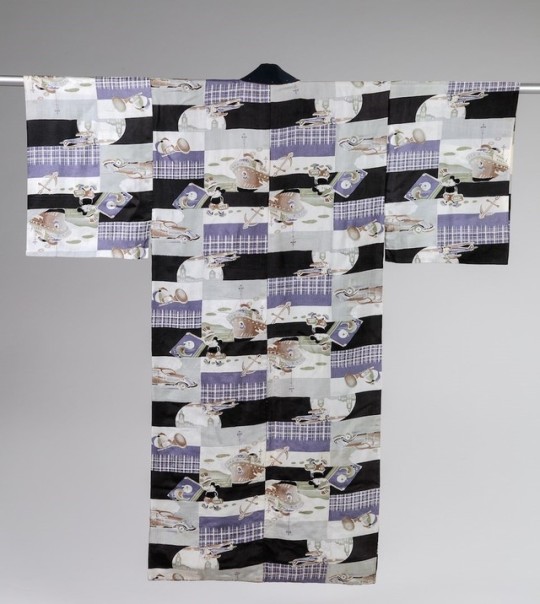
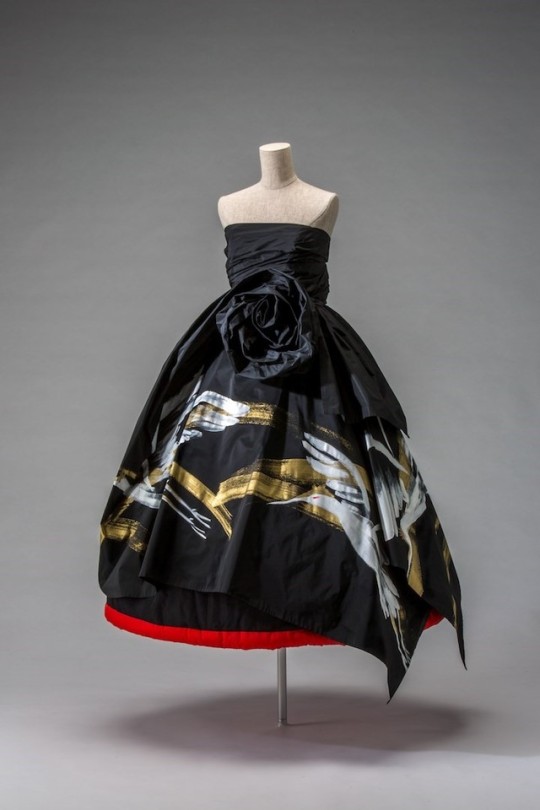

Kimono Refashioned: 1870s to Now
Now open at the Newark Museum and running through January 6 of next year is an exhibition of over forty different fashion items considering both actual kimono and the more modern garments, from the west and the east, using the kimono as inspiration.
You see here at top for their opening image, a dress by Yohji Yamamoto mixing the usual boring black of formal clothes up top combined with the large and exuberant patterned skirt from the kimono tradition. Then, a kimono from the 1930s that was inspired by Mickey Mouse--look closely and you will see the mouse appearing all over the print. Then a black dress again, this time with a painted skirt again by Yohji Yamamoto, and finally a very short dress by John Galliano from 1994.
There is a book for sale too, if you cannot make it to the show: https://www.newarkmuseum.org/kimono
#kimono#vintage kimono#newark museum#yohji yamamoto#john galliano#kimono refashioned#fashion history exhibition#fashion history book#fashion history#costume history#costume history exhibition#costume history book#dress history#1990s fashion#modern fashion#1930s fashion
14 notes
·
View notes
Photo
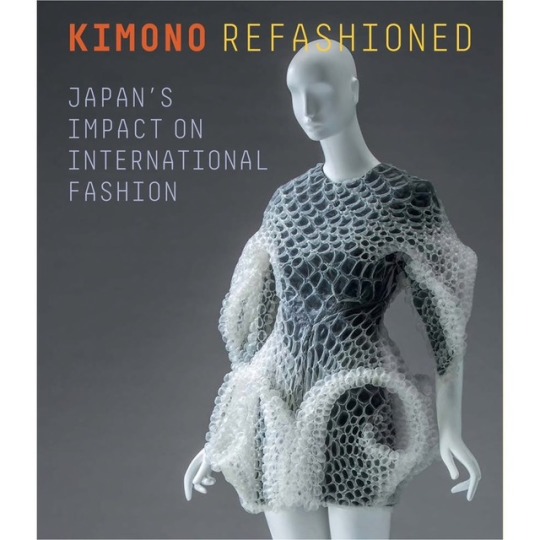

Kimono Refashioned 「モードのジャポニスム」、「Future Beauty」を踏まえ、きものが現代のファッションを刺激し、新たな創造を促している点にスポットをあてた「Kimono Refashioned」展が巡回されます。 ・ニューアーク美術館(2018 年 10 月 13 日-2019 年1月 6 日) ・サンフランシスコ・アジア美術館(2019 年 2 月 8 日-5 月 5 日) ・シンシナティ美術館(2019 年 6 月 28 日-9 月 15 日) なかで、ひなや「mitasu+ ANREALAGE」も展示されます。 お近くに行かれる機会がございましたら、是非ご覧ください。
2 notes
·
View notes
Text
New Beginnings

View On WordPress
0 notes
Video
( ¨̮ )゚・*:.。❁ #sewing #diy #costura #sewingproject #diyfashion #seamstress #sewinglove #isew #memadeeveryday #sewcialists #thrifted #upcycled #refashion #kimono #drawstringbag #お裁縫 #ソーイング #ハンドメイドバッグ #手作り #巾着バッグ #裁縫 #diy女子 #ミシン #自製 #手作 #包包 #만들기 #작업 #바느질 #소잉
#ハンドメイドバッグ#sewing#ミシン#바느질#包包#작업#thrifted#手作り#refashion#만들기#diy女子#お裁縫#diyfashion#巾着バッグ#手作#seamstress#diy#costura#kimono#소잉#isew#自製#sewcialists#upcycled#sewingproject#drawstringbag#ソーイング#memadeeveryday#裁縫#sewinglove
1 note
·
View note
Photo

More than one year waiting to see if the color fade away or change. Happy to confirm that after more than a year the Natural colors of Logwood and the leaves didn't change at all 💚 in a 100% polyester Blouse from Zaragoza #nofilter •••••••••• 🌿 •••••••••• #naturaldyes #color #upcycle #startup #remade #ReFashion #textile #entrepreneur #handmade #germany #deutschland #bremen #ethicalfashion #ecofashion #refashioned #sustainablefashion #noavys #kimono #color #logwood #blauholz #purple #bohochic #bohemian #chic (en Bremen, Germany) https://www.instagram.com/p/B_uYtSPJJIr/?igshid=9rkbw2hsdpp9
#nofilter#naturaldyes#color#upcycle#startup#remade#refashion#textile#entrepreneur#handmade#germany#deutschland#bremen#ethicalfashion#ecofashion#refashioned#sustainablefashion#noavys#kimono#logwood#blauholz#purple#bohochic#bohemian#chic
0 notes
Text
Project: silk tank top refashion
Introduction:
I've got this top that doesn't fit me any more: it's a bit too large, and the design doesn't flatter me. I absolutely love the fabric though, so I decided to refashion it into a different design.
Clothes are just bits of fabric cut and sewn into specific shapes. If you don't like something any more, it's totally fine to take it apart and turn it into something else!
The project:
The top is a simple tank top design made out of a woven fabric and with a button at the neckline. The button is decorative: the top doesn't have any closures as it has sufficient ease to slip on over your head.

[ID: an emerald green tank top lying on a black and white chequered floor. The top has a white button at the rounded neckline, a rounded bottom hem, and a seam at the centre front.]
Remember my one hour dress? I traced the top part onto paper: the result is a sewing pattern for a top that has enough ease to work on both knit and woven fabrics. Perfect for my non-stretchy shirt!

[ID: the green top lying next to a paper pattern for a top with a kimono sleeve. The pattern has been traced onto the green top with blue chalk. The photo is blurry.]
When I traced my pattern onto my top, I realised I had some extra room at the sides. I used this to add frills at the sides of the top. I left two rectangles at the bottom of the top for this purpose.
I cut out my pattern and sewed up the side seams.

[ID: an unfinished green top with kimono sleeves, a round neckline, and fabric rectangles protruding at the bottom of the side seams.]
I cleaned up the shape of my neckline as it was uneven.
I then cut horizontal slits at the bottom sides of my top that were about half the length of the fabric rectangles I'd left a the bottom of my top. I gathered my excess fabric to match the size of the slits, and sewed it in place to create a ruffle.
Check out this Closet Historian tutorial to learn more about this ruffle technique.
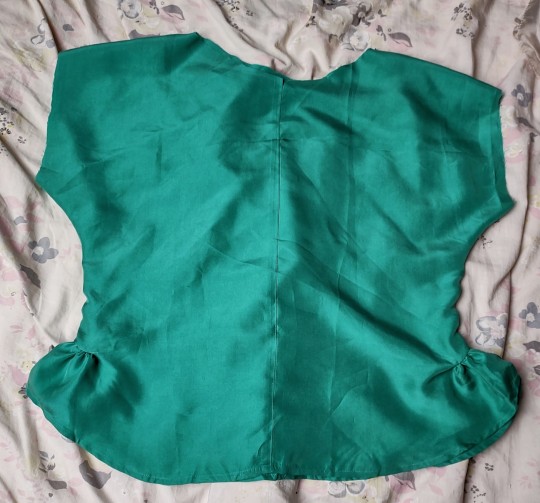
[ID: an unfinished green top with kimono sleeves and a round neckline lying on top of white bedsheets with a floral print. Ruffles sit at either side of the bottom of the side seam.]
I finished off the sleeves with a double fold hem, then decided to tackle the neckline. As I was working with the body of the original top, I still had the yoke left that I had cut off earlier. I turned the yoke fabric into bias tape.
Bias tape is great for necklines because it's slightly stretchy. This helps to accommodate the round shape of the neckline. There's multiple ways to bind a neckline with bias tape: check out this Sew Guide article to learn more.
Bias tape is also great for sleeves, but I didn't have enough fabric to do both the neckline and the sleeves. Hence the double fold hem.
I pinned my tape right sides together to the outside of my neckline, then sewed it in place. I then folded up the tape and ironed it flat, then folded it back down again towards the inside of the shirt. I tucked in the raw edges, ironed again, then sewed it in place.
This technique gives your neckline a crisp finish. The bias tape is not visible on the outside of the shirt.

[ID: close-up of the neckline of the green shirt. Matching green bias tape has been pinned to the outside edge of the shirt, right sides together.]

[ID: close-up of the neckline of the green shirt. Matching green bias tape has been sewn to the edge of the neckline, then ironed flat.]
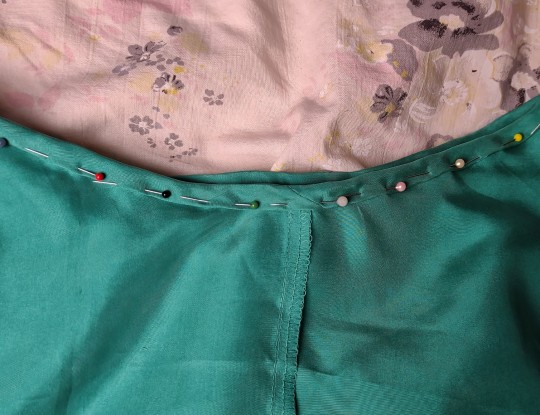
[ID: close-up of the inside of the green shirt's neckline. Matching green bias tape has been sewn to the outside edge of the shirt, then folded into the shirt. The raw edges have been tucked in and pinned into place.]
I kept the original bottom hem of the shirt because I liked its rounded shape. It's sewn with thread that's a perfect colour match to the green fabric. My thread, while close, was not a perfect match and would stand out if I had used it on the outsides of the shirt. That's why I chose to use metallic thread to sew the sleeve hems and neckline: that way, the golden hem stitching functioned as a subtle decorative detail.
I plan to add embroidery in the same gold-coloured thread at some point in the future. I also have gold beads left in my stash that could look cool. I'll have to think about it.

[ID: the finished green shirt. The round neckline and kimono sleeves have been hemmed with gold metallic thread. Ruffles sit at the bottom of the side seams of the shirt.]
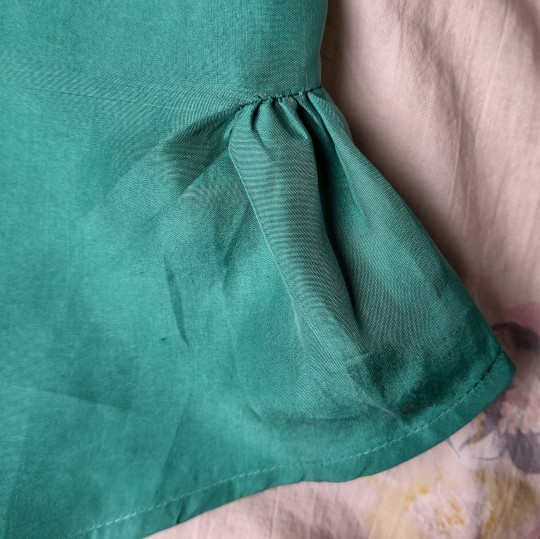
[ID: close-up of one of the ruffle at the bottom side seam of the shirt.]
Conclusion:
I love the fabric of this top, so I'm glad I kept it even if it didn't fit properly any more. I now have a cute summer top that flatters my figure.
The pattern I traced is a great addition to my collection. Its simplicity makes it very versatile. I could easily turn it into a dress, a cardigan, a button-up shirt, a sleeveless top, or give it dolman sleeves, just to name a few ideas.
I plan on adding more decorative details in the future, but I have very little patience when it comes to metallic thread so I figured I'd keep that for a later time. The top's good enough for now.
If you'd like to draft your own pattern like this, check out my one hour dress post. The pattern I used is the top part of the dress.
#wasteless crafts#project#refashion#shirt#top#summer top#silk#fashion#fast fashion#slow fashion#sustainable fashion#sustainability#zero waste#zero waste crafts#diy#sewing#fibre crafts#upcycling#reduce reuse recycle#kimono sleeves#ruffles#sewing techniques#how to#bias tape
182 notes
·
View notes
Photo

#Upcycled # Patchwork Cardigan Vicky Myers shares how she created an adorable kimono style cardi from a bunch of thrifted shirts:
#diy cardigan#diy clothing#diy kimono#ecofashion#patchwork refashion#preloved#refashionista#upcycled clothing
0 notes
Text

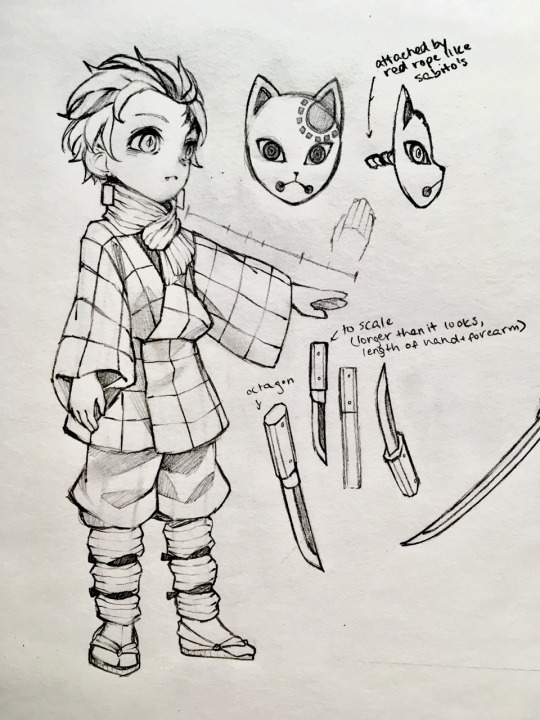

Sorry for not posting much recently, I have some classes that pretty much take up the entire day :/
But here’s some more stuff for kny roleswap au!
I think I’m going to have Tanjirou’s main weapon be a knife, because the dance of the fire god can be translated to using a one-handed weapon. A knife is small enough for him to hide and doesn’t give him an overwhelming advantage like a sword does. Since he’s not really an official demon slayer, he can’t walk around with a sword without being questioned, anyways.
(Though even normal demon slayers are questioned for having a sword since they’re unrecognized by the government, at least people have heard stories and won’t immediately detain them for having a sword)
And Nezuko has short hair! Mostly I draw her with a short ponytail, but two years pass between her starting her training and her becoming a demon slayer, so she grows out her hair in that time. (The first time she cut it was to prove a point to her brother. Now that the point was proven, she didn’t need to keep her hair short. She found that it flew in her face when she was doing things, and a ponytail was a lot more convenient for keeping her hair back.)
Also, she refashioned a few of her things to serve different purposes. A lot of people ignore that she has that red and white checkered obi belt, because her kimono pattern is what stands out mostly, but I think the obi has meaning as a link to the Kamado family. If you go back to the first episode, everyone in the family has checkers somewhere on their clothes, even if it’s subtle, like a few rows on a haori. Since it has that meaning, I don’t think she would just throw it out after not needing to use it, so she’d probably find another way to incorporate it into her outfit. I thought a scarf would fit.
Also, her haori while she trains is still the brown/black one she usually wears since she hasn’t had the time since she started training to turn her pink kimono into a haori.
Her kimono is actually not her usual kimono, but the one she wears in episode 1 when Tanjirou tries to take her to a doctor. I feel like she’d want to save her normal one, since she mentions it was her favorite, so she wouldn’t wear it while training.
Also, she has a scar on the left side of her face from a training accident. Not unthinkable, since a while into training, Urokodaki uses real blades for his traps rather than stones and empty pitfalls. I think she was distracted by her brother in a coma while she was training.
And her brother doesn’t start training for a while, instead opting to watch over Nezuko and make sure she’s alright before he begins. But since Nezuko always comes back injured, he keeps getting worried and can’t sleep. Which is bad for him, since all his nourishment comes from sleep, which is why he falls into a coma. It’s shorter than Nezuko’s though, and Urokodaki starts training him afterwards to get his mind off of Nezuko and wear off some of his energy, so he can sleep better.
I tried to think a lot about reasonable chains of events, so I hope you enjoy! I I have a fic on ao3 for this, if you want to check it out. Sorry for ranting!! :)
363 notes
·
View notes
Text
Japan Fashion Culture

Issey Miyake’s 2016 pleated menswear features iconic Japanese erotic art .

As my first assignment within this course, we were assigned to groups and countries, in my case was Japan. To further explore the fashion history and what historically or colonially shaping events affected this country. If, there was an international effect for our assigned country on the international fashion industry throughout history or the meantime. We explored the rich Japanese culture and how there is a significant impact of kimonos throughout history internationally.
One of the funniest information I learned during this research project is that KIMONO Literally meaning ‘a thing to wear’, which to be used as a daily garment worn by both men and women. These days, it’s mostly reserved for special and formal occasions. There is a difference in the way the women wear them. As far as color is concerned, women have more options for colorful patterns, while the OBI, which is the belt that holds the kimono tight, is another important part of traditional Japanese clothing. The man's obi is thinner, with subtle colors and patterns. Women's obis are thicker with more color, pattern varieties, and more decorative ways to bind the obi to women than to men. So, you might see women with their obi tied up like a flower or a butterfly on their backs. A zōri is a type of sandal worn with a traditional outfit that resembles the design of flip-flops, except that the base of the shoe is a block of wood rather than rubber or plastic. This footwear is worn with white socks that are normally covered in a robe.
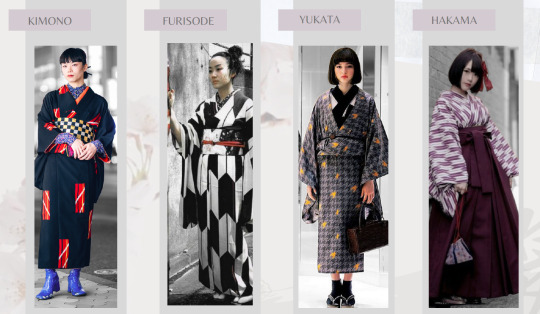
The Japanese culture impacted European art and fashion at the turn of the 20th century when Japan reopened to trade with the West, a tidal wave of Japanese imports, including woodblock prints, fans, ceramics, and kimonos.

KIMONO REFASHIONED
The exhibition "Kimono Refashioned" begun in 2018 in the Asian Art Museum. It's a tour of three major American cities. Kimono Refashioned features clothing, accessories, and artwork by a variety of artists and designers, several well-known fashion masters of the past like Coco Chanel, and also contemporary innovators such as Issey Miyake, Tom Ford, and Iris van Herpen.
The kimono has influenced the ideas of many designers, providing inspiration for new opportunities, famous designers who have explored the creative possibilities of the Japanese kimono include Alexander McQueen, Yves Saint-Lauren, and Cristobal Balenziaga, Christian Louboutins.

Era-spanning looks in the Asian Art Museum exhibition “Kimono Refashioned” from the Kyoto Costume Institute include (from left): a silk and satin damask dress from London (circa 1875); Dutch designer Iris van Herpen’s 2016 mono-filament organza dress; and a 1913 silk satin and crepe beaded evening coat from Paris’ House of Amy Linker. (Courtesy Ming Vong/S.F. Examiner)

Christian Louboutin’s boots, autumn/winter 2017 collection. (© Kyoto Costume Institute)
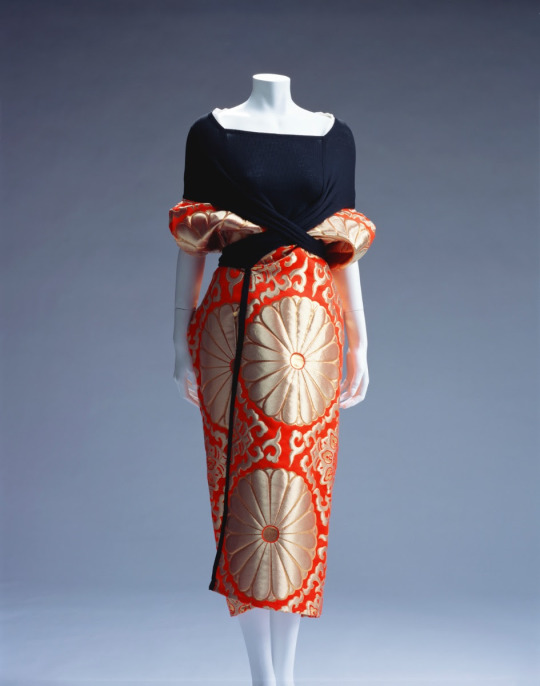
Dress, Spring/Summer 1995, by Yohji Yamamoto (Japanese, b. 1943). Collection of The Kyoto Costume Institute. © The Kyoto Costume Institute, photo by Takashi Hatakeyama
14 notes
·
View notes
Photo

Kimono Refashioned - Asian Art Museum
If you live near or are planning to visit San Francisco, California this Spring you may want to check out this exhibition open February 8th to May 5th, 2019. Click here for more information and highlights of the design selections.
“Featuring over 35 garments from the Kyoto Costume Institute, Kimono Refashioned shows us that kimono continue to be a fertile source of ideas for contemporary designers, both in Japan and across the globe.”
Here at Kyoto Kimono we have a vast selection of vintage Japanese kimono and other garments. Browse our store and perhaps you’ll be inspired!
#kimono#Japanesekimono#Japanese kimono#asianartmuseum#vintagekimono#kimonodesign#kimonoart#i love kimono#Japanese design#kimonorefashioned#kimono refashioned
3 notes
·
View notes
Photo

Thank you for my beautiful new goody, @refashioned !! ❤️ I love the idea behind this amazing company -- they make gorgeous sustainable bags & accessories from up-cycled vintage kimono fabrics. So it's like throwing the planet a big kiss too! 💋🌎❤️😘
(via @@jerilryan on Instagram)
26 notes
·
View notes